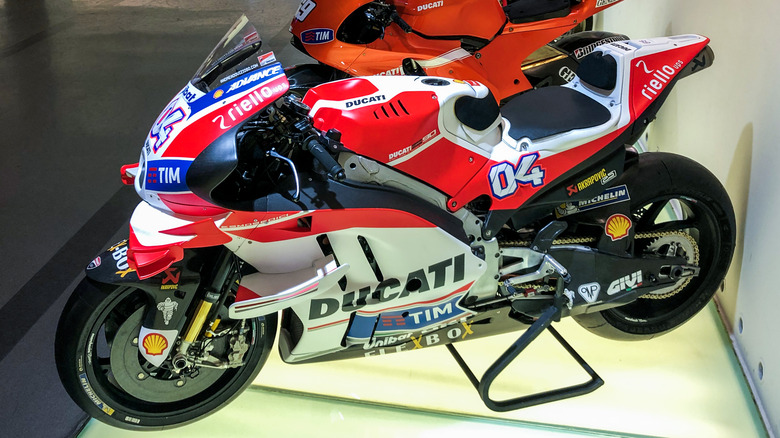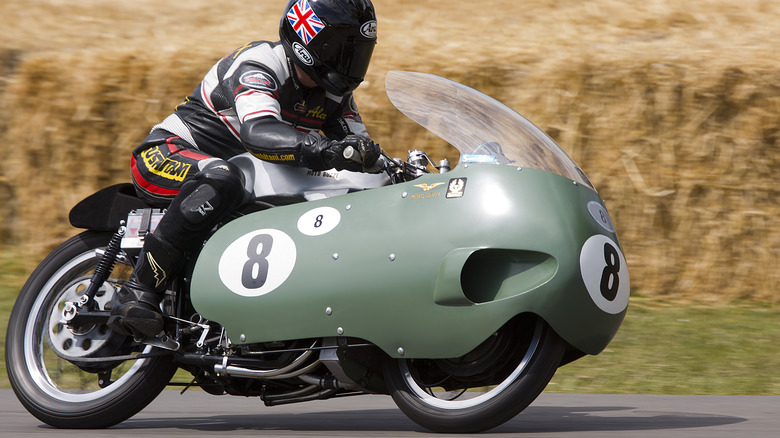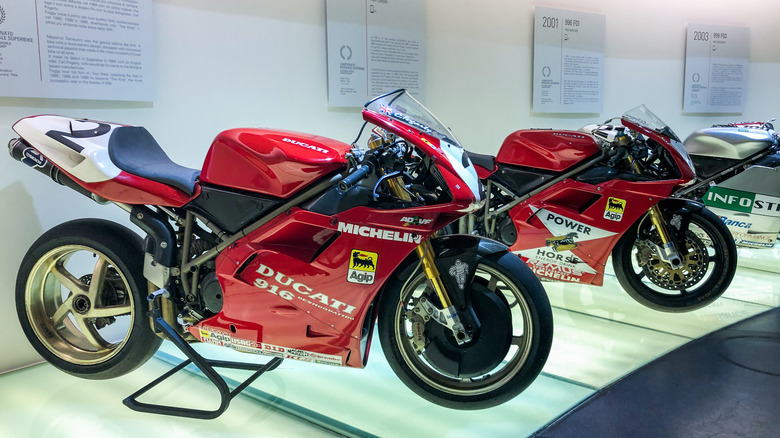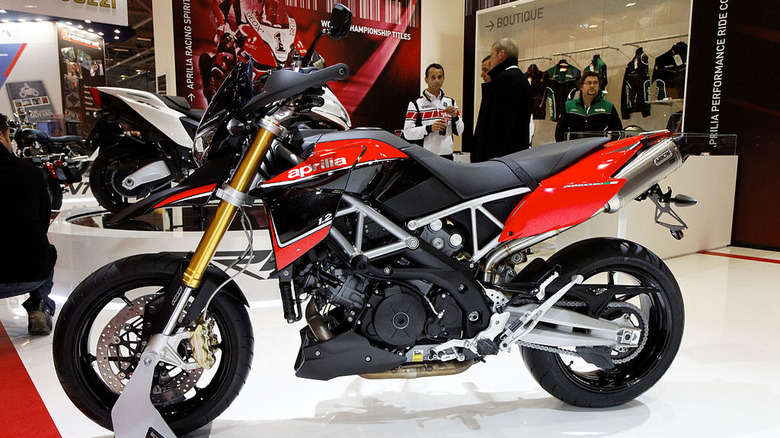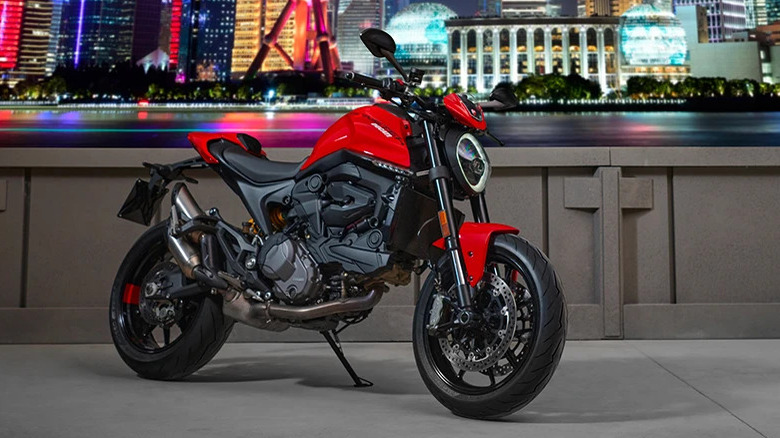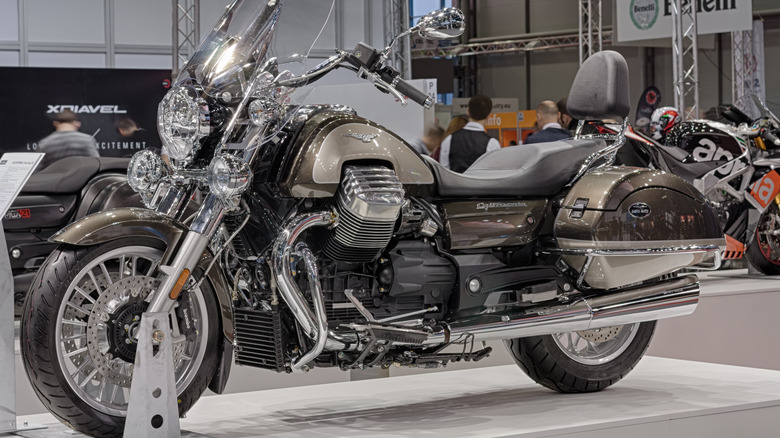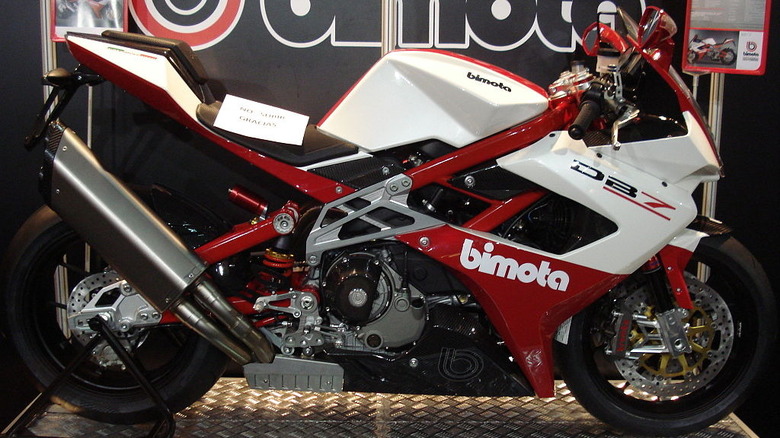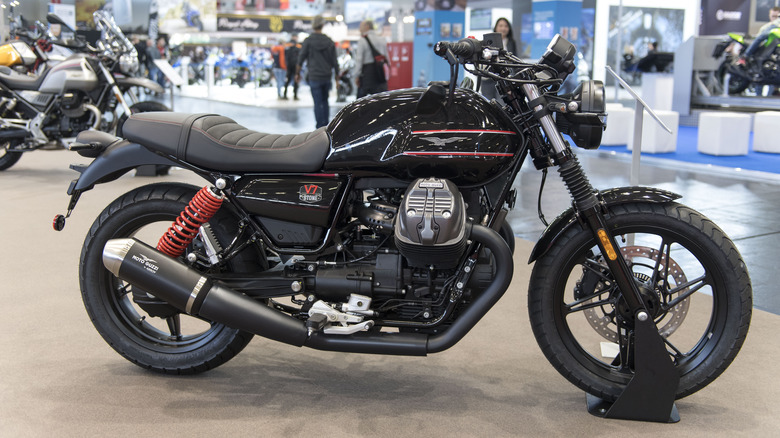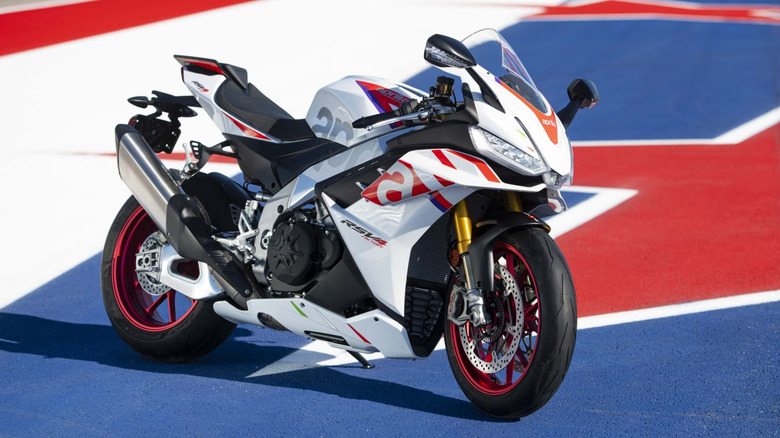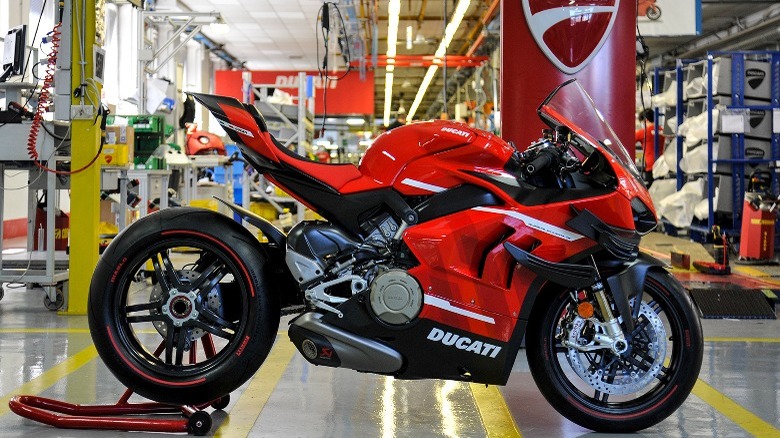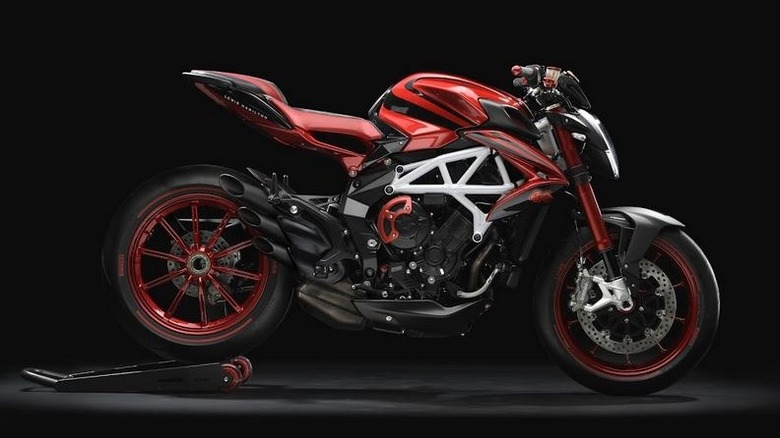10 Of The Greatest Italian Motorcycles Ever Made, Ranked Worst To Best
Italy is a country that is steeped in automotive tradition, and just as it is renowned for its legendary supercars from marques that include Lamborghini, Ferrari, and Bugatti, the Mediterranean nation is equally adept at producing aspirational motorcycles. These bikes combine the performance and engineering prowess for which Italians are known alongside superior artistry, resulting in some of the most visually appealing, well-crafted motorcycles ever built.
Yet for all their beauty and heritage, Italian bikes are, generally speaking, much more expensive and not as reliable as their counterparts from Japan, the country's biggest competitor in the premium motorcycle market. They are often bested both in terms of sales and performance by motorcycles from fellow EU nation Germany, and yet a Ducati is more likely to adorn posters in teenagers' bedrooms and calendars on garage walls than a BMW bike.
So which Italian motorcycles have the most allure? Which models have consistently outperformed the competition to achieve legendary status? Which are the most fun to throw through the twisties with abandon? We answer these questions by ranking the greatest Italian motorcycles in history, considering their influence, heritage, construction, features, and performance.
10. Moto Guzzi V8
The 1950s saw a sea change in motorsports as the technology improved to facilitate more competitive racing at greater speeds. One bike in particular, the Moto Guzzi V8, was front and center as one of Grand Prix motorcycle racing's earliest stars. Designed especially for Grand Prix racing, the 499cc Otto, as it became known, was a trailblazer within its class, paving the way for new and innovative technologies as the first racing bike to have a DOHC V8 engine. It was the model that put the fledgling manufacturer on the map as a producer of high-performance bikes, and it fared well in Grand Prix and TT competitions between 1955 and 1957.
You only have to look at the V8 Otto to see how much it influenced the motorcycles of today. Features such as its racing saddle, sculpted fuel tank, clip-on handlebars, and full fiberglass faring are all commonly seen on modern machines. Performance-wise, it was impressive, even by today's standards, with a top speed of 178 miles per hour and an engine that produced 80 brake horsepower at 12,000 rpm. Even the Otto's handling was considered far better than average, and its unsophisticated drum brakes were said to be capable enough to bring its nearly 300 lb frame to a standstill at speed, although few modern riders would be happy to put this to the test.
Due to the primitive nature of this historically significant motorcycle, it makes the lowest level in this ranking. However, it's also worth asking — if it weren't for the Moto Guzzi V8, would the likes of the Bimota DB7 or the Ducati 916 even exist?
9. Ducati 916
Ducati's marketing insists that the company adheres to the values of "style, sophistication, and performance" when designing motorcycles. All these came to a perfect head in 1994 with the introduction of the Ducati 916.
The 1990s were a fruitful time for Italian sports bikes as they started to really come into their own as competitors to their great Japanese rivals: Honda, Kawasaki, and Suzuki. The Ducati 916 led the charge, winning four World Superbike championships and establishing Ducati as an unparalleled designer of high-performance motorcycles. It's hard to think of a bike that has made more of an impact on the sports bike category, despite a production run of only four years.
Standout features of the 916cc racer include a single-sided swingarm, under-seat exhausts, three-spoked wheels, and inverted forks, which are now commonplace on bikes of this segment. Its 109 brake horsepower engine propelled it to 160 miles per hour, but most importantly it cornered like a dream and was a joy to ride in a time before rider assists and onboard computers were standard.
Of course, no bike is perfect, and the Ducati 916 didn't fare so well in the reliability stakes, leaving it nearer the bottom of this ranking. Of course, this isn't a mile-munching touring bike — it is a thoroughbred racer, and if you are lucky, you might still see a looked-after model flying past you on the freeway almost 30 years on.
8. Aprilia Dorsoduro 1200
It could be said that the Italian motorcycle brands are best known for their dedicated machines that sit within the sports and cruiser segments. Aprilia is a little more diverse, as while it does produce some incredible sports bikes, it also makes a great adventure bike in its Tuareg 660 as well as one that blends elements of both styles — the Aprilia Dorsoduro 1200.
Introduced in 2008, the Dorsuduro (meaning "hard back") has a 90-degree V-twin engine and is available in 750cc and 1200cc variants. As an overpowered supermoto with touring capabilities, the 1200 option is one of Italy's more versatile motorcycles, and it comes loaded with the gadgets and features you might expect from a modern machine such as this. These include electronic ABS, traction control, three riding modes (sport, touring, and rain), and a multi-function display.
Refreshingly, the Dorsuduro range has returned good reliability ratings, which is essential for a bike of this segment as it should be expected to be ridden hard over long distances. Its 1197cc engine produces 130 brake horsepower, and this will leave most of its rivals, such as the KTM 990 SMR, for dust. It performs well (provided you are tall enough, with its over 31-inch seat height), although this bike is better suited to sweeping roads than tight maneuvers on uneven trails. While the Aprilia Dorsoduro 1200 may lack the heritage and star power of some of its (more expensive) compatriot motorcycles, this plucky supermoto is well-deserved of its place on this ranking.
[Featured image by Thesupermat via Wikimedia Commons | Cropped and scaled | CC BY-SA 3.0]
7. Ducati Monster 937
The end of the 20th century was a productive and progressive time for Ducati, and by creating the Monster in 1993, the marque began making "naked bikes" in the style of the Triumph Street Triple. The Ducati Monster became one of the most recognizable within its segment, and the 937 is the latest incarnation of this formidable line of machines to live up to its macabre moniker.
It is immediately apparent that this is no fully-fared track racer that we usually see from Ducati. Instead, the Monster 937 is an aggressively styled, stripped-down street bike that bares its skeletal construction with pride, like something from an H.R. Giger illustration. Yet everything is meticulously appointed, from its upswept twin exhausts to its sculpted mirrors and headlamp cowl. It looks at once menacing, sporty, and practical with its low seat, high ground clearance, and upright riding position.
The Ducati Monster 937 is likely the most accessible bike in Ducati's lineup, especially as you can buy a version for novice riders that is limited to 35 kW. Those seeking the credibility and heritage that comes with Ducati ownership but who don't wish to commit to a road rocket with a hunched riding position and clip-on handlebars could find the perfect Italian motorcycle in the Monster 937.
6. Moto Guzzi California
While Italian motorcycles are better known for their fully-fared racing machines, they make an excellent cruiser, as evidenced by the Moto Guzzi California. Here, the brand has proven, once again, that it is adept at combining traditional styling with modern construction techniques and materials, and the result is a contemporary classic that offers riders the best of both worlds.
Initially developed for the Los Angeles police in the late 1960s, the California became a popular bike in the United States due to its exotic European appeal matched with American cruiser characteristics. These include its wide handlebars, low seat, tall windshield, and robust V-twin engine, with the latest models boasting a 1,380cc block that produces 95 brake horsepower. Unlike many U.S. counterparts, the Moto Guzzi has a comfortable, upright seating position, with sensibly-placed floorboards and a handlebar height that accommodates many hours of effortless riding.
The Moto Guzzi California handles well, has plenty of luggage space, and fares well in reliability tests, making this a practical and fun highway hog that costs less than a Harley but still retains plenty of heritage and bags of style. While it certainly deserves a spot on this ranking, the California lacks the intrigue and broader appeal of those bikes higher up on the list — even though it is most likely the best Italian cruiser ever made.
5. Bimota DB7
Bimota used the same name format for its motorcycles as the British brand Aston Martin did for its cars. However, as a former air conditioning company that branched out into performance bike production under the steady hand of Massimo Tamburini (designer of the legendary Ducati 916), the Italian marque could not be more distinct from James Bond's chosen carrier.
Bimota is perhaps the least recognizable of all Italian bike brands, yet it made some of the most desirable machines ever. The Ducati-powered DB7 was the brand's swansong superbike before the company was sold to Swiss contractors, and it was one impressive machine that married looks, performance, build quality, and power. At just 379 pounds it was incredibly light for a bike with a 1099cc capacity, a top speed of 161 miles per hour, and an acceleration of 0-60 miles per hour in under 3.6 seconds.
With its lightweight construction materials — including aluminum, carbon fiber, and titanium — alongside its premium parts and accessories, the handcrafted DB7 commanded a premium price. True to Bimota tradition, this motorcycle caught the imagination, and it was about as exclusive a machine as you could buy at its release in 2010. As such, it is undoubtedly one of the greatest Italian motorcycles ever made but places lower in this ranking than more attainable machines from more popular brands.
[Featured image by m.caimary via Wikimedia Commons | Cropped and scaled | CC BY 2.0]
4. Moto Guzzi V7
Fans of the Triumph Bonneville would naturally gravitate towards the Moto Guzzi V7, one of the best Moto Guzzi motorcycles ever made. With its classic lines, 90-degree 850cc V-twin engine, and two-tier saddle, this motorcycle is built with style, power, and comfort in mind. Introduced in 1967 and still in production today, the V7 remains one of the Italian marque's most popular bikes, thanks in no small part to a recent 2021 overhaul to celebrate the brand's centenary.
This new rendition of the old favorite is more than just a makeover. The V7's engine has been plucked from the Moto Guzzi V85 TT and is the brand's most advanced and efficient power unit to date. It has been given an injection of steroids, with a fatter rear wheel, larger exhaust pipes, and chunkier shock absorbers. Meanwhile, LED lighting replaces the previous halogen bulbs, and steel accents have been applied throughout to give it a premium feel.
While the fit and finish are undoubtedly excellent, the V7 is light on tech, as it should be on a classic motorcycle. Those looking for multiple rider assists and a full TFT screen should look to a Ducati Multistrada or even the aforementioned V85 TT. However, you are treated to basic traction control, ABS brakes, and an inset LCD that tells you the time and odometer reading, among other things. The Moto Guzzi V7 is unassuming, and many motorcyclists appreciate a machine that doesn't try too hard to be something it is not and simply gets you there in style. Hence, it ranks well on this list.
3. Aprilia RSV4
To the casual observer, the Aprilia RSV4 looks much like any other superbike, with its full faring, upswept exhaust, clip-on handlebars, and aggressive rider position. Yet, as the architect Ludwig Mies van der Rohe once said, "God is in the details," and in the RSV4, Aprilia has created something worthy of worship.
The RSV4 is the flagship superbike from the highly-respected Aprilia brand. Available as a limited, racing-optimized factory model and a standard version, it is the best bike the brand has ever made, starting with its exceptional engine. This is a 1,099cc narrow-V, four-cylinder power plant that is both lightweight and compact but extremely powerful. It provides 125 Nm of torque at 10,500 rpm and 217 horsepower, boosting the bike to a top speed of almost 190 miles per hour.
Design-wise, the Aprilia team has integrated winglets into the RSV4's double-layered faring, improving stability and aerodynamics while maintaining the bike's sleek appearance. A lightweight, reinforced swingarm and upgraded electronics help improve upon the previous-generation RSV4's already-impressive performance, making the latest version a cut above the rest.
The Aprilia RSV4 is not without considerable competition in the liter-class superbike segment, from the likes of the Kawasaki ZX-10R, Honda Fireblade, Yamaha R1, BMW S 1000 RR, and even its own compatriot Ducati Panigale V4 S. However, the Aprilia holds its own and even outclasses some of its rivals. This is one among many reasons that the RSV4 deserves a place in the top three greatest Italian motorcycles ever made.
2. Ducati Superleggera V4
As a rule of thumb, if something, be it a Salvador Dali print or a Faberge egg, comes with a certificate of authenticity and a number, you know you have something special in your midst. The limited-edition Ducati Superleggera V4 is one such work of art that is simply too extraordinary to be made widely available to the masses, and those lucky enough to get their hands on one of the 500 produced are treated to exceptional build quality, refined components, and blistering performance.
The Superleggera's performance is buoyed by the fact that its name translates as superlight, a name that the bike lives up to with a dry weight of 350 pounds. This is due to a combination of its lightened 998cc V4 engine, carbon fiber body, carbon fiber frame, carbon fiber wheels, a carbon fiber single-sided swingarm, and a titanium-sprung suspension, among many other weight-saving measures employed. The Superleggera V4 produces a massive 234 horsepower, or a power-to-weight ratio of 1.54 horsepower per kilogram, which results in incredible braking power and handling — not to mention a top speed of 200 miles per hour.
While the specifications are undoubtedly impressive, Ducati has managed to create a high-performance motorcycle that doesn't compromise on aesthetics either. Every inch of its profile is meticulously sculpted to please both the eye and the wind tunnel, resulting in a perfect symbiosis of function and form. It is arguably the greatest Italian motorcycle ever built, as there is only one other bike that can challenge it.
1. MV Agusta Brutale 1000 Serie Oro
If you need proof that Italian motorcycles match Italian supercars in terms of aesthetics and performance, then this is it. The MV Agusta Brutale 1000 Serie Oro was produced in a limited number of 300 units and is undoubtedly one of the most beautiful and coveted machines the Italians have ever made. It holds the title of the world's fastest naked bike, and it caps a lineage of Brutale models that collectively rewrote the definition of what a sports bike should be.
The Serie Oro's engine is a massive four-liter, four-cylinder power unit, delivering 208 horsepower at 13,450 rpm and 115.5 Nm of torque, driving it to a top speed of 186 miles per hour. Power delivery is controlled via a ride-by-wire system, with riding dynamics including eight traction control settings, an anti-wheelie system, and launch control, all programmable via the five-inch TFT display. Ohlins provide an electronically managed suspension, and brakes are courtesy of Brembo Stylema calipers with a comprehensive Bosch ABS. This streetfighter-style bike also features carbon fiber and aluminum panels over a steel trellis, all held together with titanium bolts.
There are many candidates for the title of the greatest Italian motorcycle ever made from a long and storied history. However, as far as power, design, construction, materials, and performance are concerned, the MV Agusta Brutale 1000 Serie Oro will likely wear the crown for some years to come.
